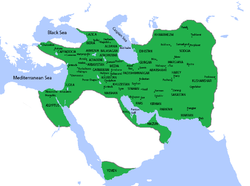Sasanian Empire
(Reguidit frae Sassanid)
The "Scots" that wis uised in this airticle wis written bi a body that haesna a guid grip on the leid. Please mak this airticle mair better gin ye can. (October 2020) |
The Sasanian Empire (/səˈsɑːnɪən/ or /səˈseɪnɪən/; cried Sassanian, Sasanid, or Sassanid an aa) or Neo-Persian Empire,[9] kent tae its indwallers as Ērānshahr[1] an Ērān in Middle Persie an resultin in the New Persie terms Iranshahr an Iran,[10] wis the last Iranian empire afore the rise o Islam, ruled bi the Sasanian dynasty frae 224 CE tae 651 CE.[2][11] The Sassanid Empire, which succeedit the Parthian Empire, wis recognised as ane o the main pouers in Wastren an Central Asie, alangside the Roman–Byzantine Empire, for a period o mair nor 400 year.[12]
Sasanian Empire | |||||||||||||||||||||||
|---|---|---|---|---|---|---|---|---|---|---|---|---|---|---|---|---|---|---|---|---|---|---|---|
| 224–651 | |||||||||||||||||||||||
 The Sasanian Empire at its greatest extent, unner Khosrau II | |||||||||||||||||||||||
| Caipital | |||||||||||||||||||||||
| Common leids | Middle Persie[4] Middle Aramaic[5] | ||||||||||||||||||||||
| Releegion | Zoroastrianism, ( Babylonian, Manichaeism, Hinduism, Buddhism, Christianity, Mandaeism, Judaism an aa) | ||||||||||||||||||||||
| Govrenment | Feudal Monarchy[6] | ||||||||||||||||||||||
| Shahanshah | |||||||||||||||||||||||
• 224–241 | Ardashir I (first) | ||||||||||||||||||||||
• 632–651 | Yazdegerd III (last) | ||||||||||||||||||||||
| Historical era | Late Antiquity | ||||||||||||||||||||||
| 28 April 224 | |||||||||||||||||||||||
| 602–628 | |||||||||||||||||||||||
• Ceevil war[7] | 628-632 | ||||||||||||||||||||||
| 633–651 | |||||||||||||||||||||||
| 651 | |||||||||||||||||||||||
| Aurie | |||||||||||||||||||||||
| 621 | 6,600,000 km2 (2,500,000 sq mi) | ||||||||||||||||||||||
| |||||||||||||||||||||||
| The day pairt o | |||||||||||||||||||||||
References
eedit- ↑ a b Book Pahlavi spelling: , Inscriptional Pahlavi spelling: 𐭠𐭩𐭥𐭠𐭭𐭱𐭲𐭥𐭩
- ↑ a b (Wiesehofer 1996)
- ↑ "CTESIPHON – Encyclopaedia Iranica". Iranicaonline.org. Retrieved 16 December 2013.
- ↑ Encyclopedia of the Peoples of Africa and the Middle East, Vol.1, Ed. Jamie Stokes, (Infobase Publishing, 2009), 601.
- ↑ Chyet, Michael L. (1997). Afsaruddin, Asma; Krotkoff, Georg; Zahniser, A. H. Mathias (eds.). Humanism, Culture, and Language in the Near East: Studies in Honor of Georg Krotkoff. Eisenbrauns. p. 284. ISBN 9781575060200.
In the Middle Persian period (Parthian and Sassanid Empires), Aramaic was the medium of everyday writing, and it provided scripts for writing Middle Persian, Parthian, Sogdian, and Khwarezmian.
- ↑ http://books.google.dk/books?id=sP_hVmik-QYC&pg=PA179&dq=encyclopedia+islam+khusraw&hl=da&sa=X&ei=B-LGUsf8DYnR4QT-loGgBg&ved=0CEcQ6AEwAw#v=onepage&q=encyclopedia%20islam%20khusraw&f=false
- ↑ Parvaneh Pourshariati, Decline and Fall of the Sasanian Empire: The Sasanian-Parthian Confederacy and the Arab Conquest of Iran, I.B. Tauris, 2008. (p. 4)
- ↑ Security and Territoriality in the Persian Gulf: A Maritime Political Geography by Pirouz Mojtahed-Zadeh, page 119
- ↑ Fattah, Hala Mundhir (2009). A Brief History Of Iraq. Infobase Publishing. p. 49. ISBN 9780816057672.
Historians have also referred to the Sassanian Empire as the Neo-Persian Empire.
- ↑ MacKenzie, D. N. (2005), A Concise Pahlavi Dictionary, London & New York: Routledge Curzon, p. 120, ISBN 0-19-713559-5
- ↑ "A Brief History". Culture of Iran. Archived frae the original on 11 October 2007. Retrieved 11 September 2009."Archived copy". Archived frae the original on 11 October 2007. Retrieved 13 Januar 2014.CS1 maint: archived copy as title (link) CS1 maint: BOT: original-url status unknown (link)
- ↑ (Shapur Shahbazi 2005)
| This airticle is a stub. Ye can help Wikipaedia bi expandin it. |

